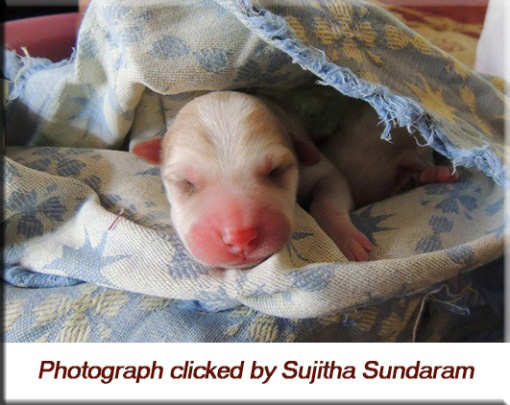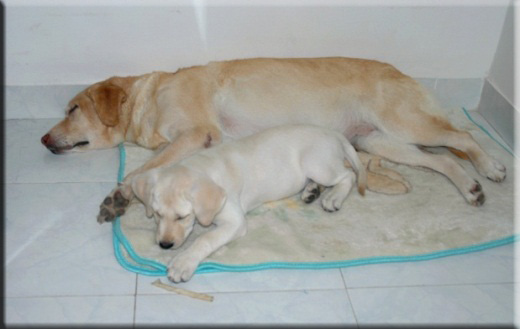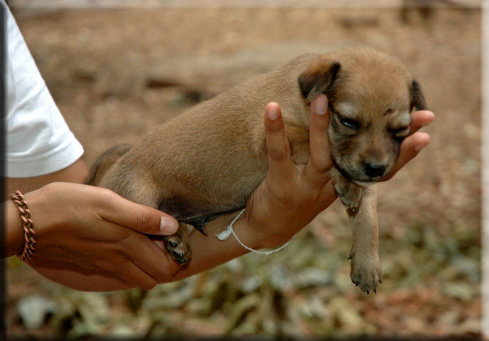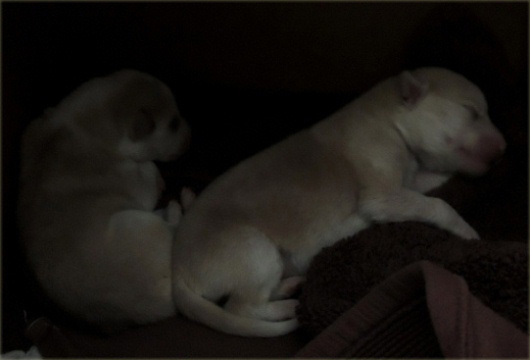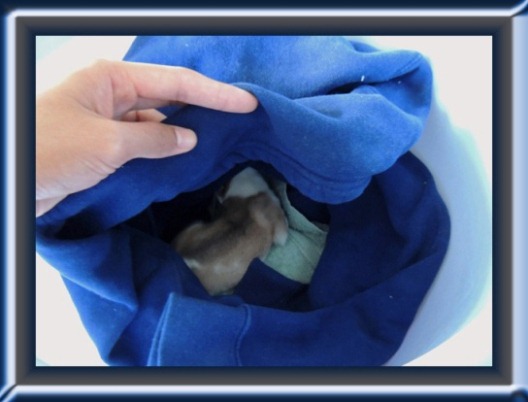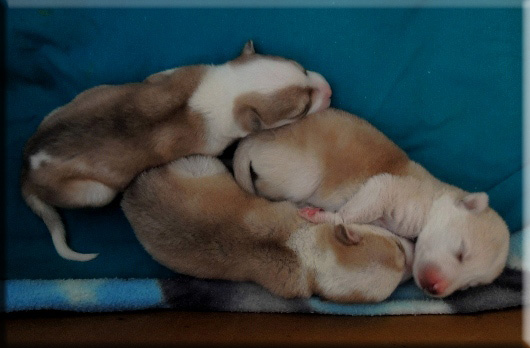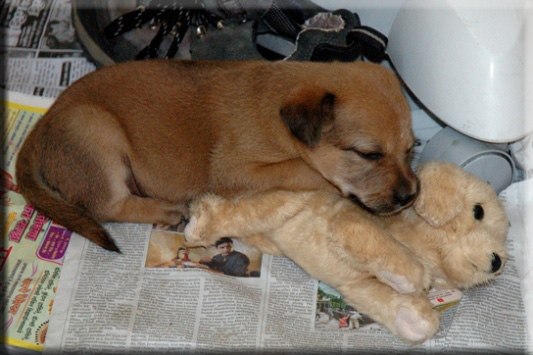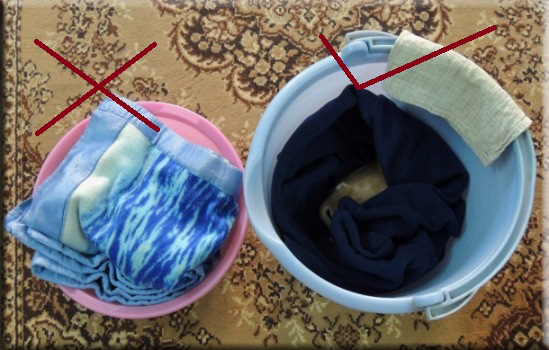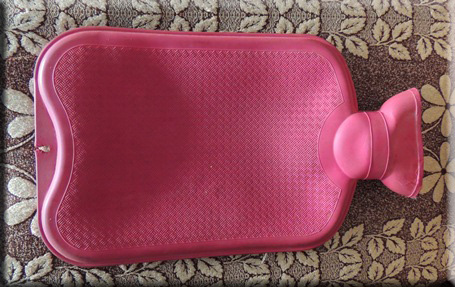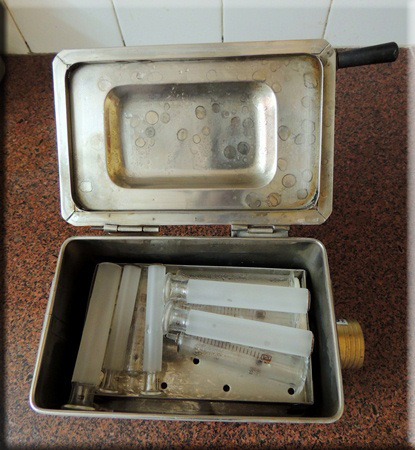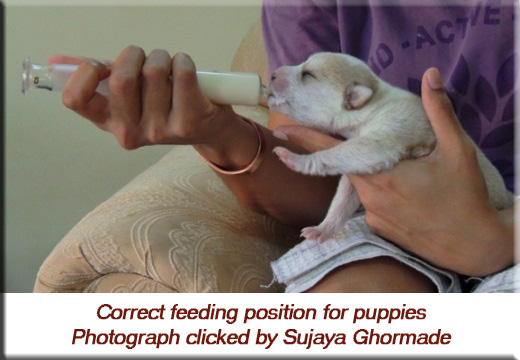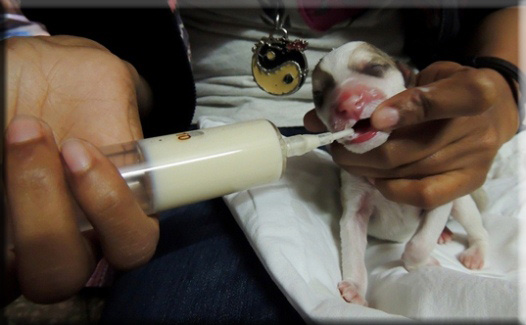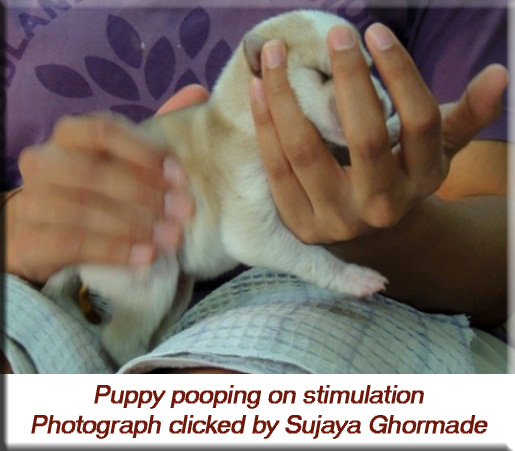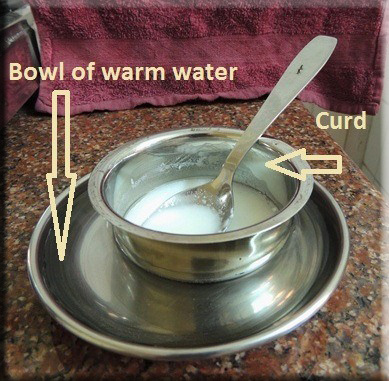Neonate care: Hand-rearing new-born puppies
Devna Arora
Similar guidelines may be used for hand-rearing non-domestic Canids. Care must be taken to minimize imprinting and handling must be restricted to 1-2 keepers.
Puppies that require hand-rearing
Young puppies are often orphaned as a consequence of losing their mothers which may be due to childbirth or road accidents. It is also not uncommon to find an entire litter that has been abandoned by humans. It is usually unlikely that people may have accidentally picked up the pups while the mother was away for a while but it is best to ascertain the cause of displacement before accepting the pups. Pups that may have a mother waiting for them must be returned to her at the earliest.
Often, a puppy may be too weak to suckle or may not be accepted by the mother. Such puppies will require your assistance and will need to be hand-fed. Sick or unfit puppies may be rejected by the mother – in addition to care, such puppies will require veterinary attention. Often, the mother may accept the pups after a few days or the puppy regains sufficient strength to suckle without help. In all other instances, the puppy will need to be cared for.
Cross fostering
Cross-fostering is a technique commonly used to foster non-biological offspring where orphaned young are offered to lactating mothers with puppies of her own. Due to a surge of maternal hormones during lactation, most females readily accept introduced babies and will care for them as attentively as she would her own. It is ideal for new-born young to be fostered by another mother if you know of any lactating females with puppies of her own. In fact, it is not uncommon for lactating bitches to have even fed leopard and tiger cubs but mothers that do not accept an orphaned puppy must never be forced to do so and the puppy must be hand-reared.
Guidelines for the hand-rearing and care of neonates
New-born puppies must be handled very gently as they are extremely delicate and can be easily injured. It is therefore advisable for the young to be handled and fed by experienced people alone.
Children may be allowed to assist in the care of the pups but only under adult supervision and they must be carefully taught how to hold, handle and care for the pups. Young puppies are especially wriggly and children must always be seated before holding the puppies. In my experience, allowing children to be involved in the care of young puppies not only gives you an extra pair of helping hands but it also instils a sense of responsibility in the child and encourages a deep and special bonding between the child and the puppy.
The umbilical cord
In most instances, the mother will chew up the umbilical cord after birth requiring little intervention on your behalf. In rare instances, you may find a puppy with the cord attached and you might be required to have the cord cut but it would be advisable to seek help from a veterinarian to do so. The cord must be cut with sterile equipment. Using unsterile equipment will only lead to infections.
The cord dries up on its own in a few days and the scab drops by itself in about a week or a maximum of 10 days. The navel is prone to infections until the cord completely dries up. It is crucial to keep the puppies and their bedding extremely clean and dry in the meanwhile. Unhygienic conditions will lead to infections.
In most cases, it is absolutely unnecessary to interfere but if required, Calendula, Neosporin or Betadinepowder [or any appropriate antiseptic powder used for dressing wounds] may be sprinkled lightly on and around the cord a couple of times a day. In addition to forming a protective layer over the cord, the powder will absorb the moisture and allow the cord to dry up without any infections.
Hygiene
Young animals have underdeveloped immune systems and are extremely susceptible to infections. It is vital to maintain very high standards of hygiene when handling the young. Hand-raised animals are at a further disadvantage of not having received their mother’s milk and the anti-bodies they would receive through it and need special care in terms of handling and hygiene.
It is essential to always wash your hands thoroughly before handling the pups especially when they are under a month old. It is important to clean your fingernails after cooking or eating food, chillies, pickles, chiwda (a spicy, savoury mix), etc. as the spices get caught under the nails. Fingernails must be kept trimmed when handling neonates. Owing to their small size, the hands and nails inevitably come in contact with their eyes while handling the pups, thereby, unintentionally scratching them or smearing the eye with spices that may burn or irritate the eye intensely. Also wash your hands thoroughly after touching any harmful chemicals like mosquito mats, insecticides, bleach, etc.
Although rare, it is important to keep in mind that the puppies may have been infected with rabies, especially if the origin of the puppies is unknown. You must therefore follow high levels of both personal hygiene and safety for the first two weeks. It is important for your safety that you do not permit biting/teething or sucking on your hands for the first two weeks. In case of a bite, contact a doctor or veterinarian immediately and follow the necessary treatment.
N.B. Once the puppies start teething, they will want to chew up everything in sight. They will particularly enjoy biting/chewing on your hands as it will give them some relief. Do not confuse this with aggression or rabies. This is a natural stage in the growth and development of the puppy.
Hypothermia
Animal young have higher basal body temperatures and should feel warm on touch. Prolonged exposure to the cold can result in hypothermia, a condition in which the body temperature falls substantially below normal and can prove to be fatal. Thermoregulation is poorly developed in young infants and they are unable to produce body heat to warm up. Consequently, rescued neonates are often in a hypothermic state when found. Even though thermoregulation develops by the time the pups are densely furred, injured and sick puppies may require an external heating source to maintain their body temperatures until they recover and regain their strength.
Heat stress
If the young have been separated for a longer duration and are in a warm location, their body temperatures are likely to be elevated beyond normal. Thermoregulation being poorly developed, the puppies will be unable to cool themselves down either. It is important to first slowly bring down the young one’s body temperature by placing them in a cool and well-ventilated area. They can also be offered a cold (mildly cold, never chilled) hydration formula as it helps in hydrating the young and bringing down their body temperature.
N.B. The young must never be either cooled or warmed too quickly.
Dehydration
Water constitutes a high percentage of body weight in young animals and they get dehydrated easily when not given suitable feeds or fed at regular intervals. Due to the time lag between having separated from their mothers and having been found and reached a rehabilitator, most young animals are quite dehydrated when they first arrive at rescue centres. The young can easily withstand the lack of food for a day but will not survive if dehydration levels peak.
Dehydrated young are unresponsive and listless. Their skin appears wrinkled; they have a weak grip and are unenthusiastic to feed. The Skin Turgor test, commonly referred to as the Tent Test, can be used to test the young for dehydration. Gently pinch a small amount of skin on the puppy’s back, to form a tent, then let go. The skin quickly goes back down to normal when well hydrated, but takes longer to go back to normal, making the “tent” evident when the young are dehydrated.
A very hot hot-water bottle must never be used for the young as it dehydrates them very quickly. The ambient temperature in the box can be gauged by placing your hand in the box five minutes after placing the hot-water bottle. If the box feels too warm and uncomfortable, the warmth of the bottle should be reduced immediately and the box ventilated to bring down the temperature.
Re-hydration
An Oral Rehydration Solution (ORS) must be used for dehydrated pups. Lactated Ringers and Pedialyte are excellent oral rehydration solutions and are advisable for cases of severe dehydration. A homemade oral rehydration solution can be made using 1 litre of water, 1 teaspoon of salt and 3 teaspoons of sugar, but must only be relied upon as a last resort as it cannot replenish other essential salts received through Lactated Ringers or Pedialyte.
Although the pups must solely be offered a rehydration solution when they are severely dehydrated, they can be offered a diluted feed if they appear to be mildly dehydrated. Feeds can initially be begun with a ratio of 60:40 feed and water with a teeny pinch of electrolytes, e.g., Electral powder. The electrolytes must be discontinued when the pups start to appear hydrated. Smaller and frequent feeds must be offered to the young until their hydration levels reach normal and normal feeds must only be begun once the pups are adequately hydrated.
Water and Digestion
The pups must always first be re-hydrated before putting them onto a regular feed as rehydration and digestion are both mutually exclusive processes. Water is not only a prerequisite for digestion but also enables the body to perform other vital functions. When food is introduced in to the stomach, the stomach draws out water from other cells of the body to aid the process of digestion. Even a dehydrated body will give up fluids to aid digestion, leaving the body further depleted of fluids. Water in the stomach is only absorbed after it reaches the small intestines and proves to be insufficient to refill the deficit that has already been created. The digestive demands made by food thus cause a further depletion of body fluids and exacerbates dehydration which can prove to be fatal for the young if not addressed immediately.
Handling small puppies
Puppies must be completely supported every time they lifted or carried. Puppies that are supported inadequatedly will inevitably wriggly due of discomfort and hurt themselves. Smaller puppies may be held in one hand while bigger or older puppies must be held in both hands.
Children must only be allowed to handle smaller puppies in adult supervision. The most appropriate way for a child to hold a puppy is to squat and hold the puppy on his or her lap. Ensure that the kids have washed their hands thoroughly and put on a clean pair of clothes before handling neonates.
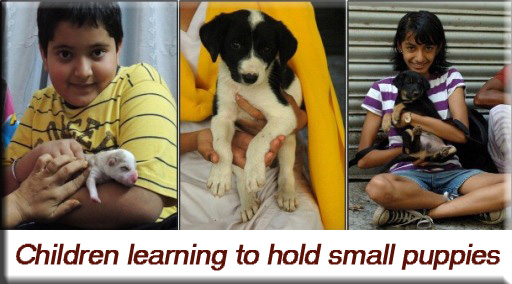
Housing new-born puppies
The puppies must always be housed in a warm, dark and quiet place. Puppies under the age of 3 weeks can be housed in a cardboard box as it is easier to keep the puppies warm in an enclosed space. Being in a contained space also keeps the puppies from crawling away.
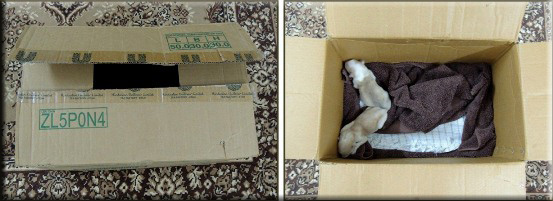
A box that is approximately 2-3 feet in length and breadth will comfortably house 4-5 new-born puppies for the first couple of weeks of their life. The box should be at least 1 ½ foot high as the bedding and hot-water bottle will take up nearly half a foot. The top of the box needn’t be closed shut but may be kept sufficiently open for ventilation. The hot-water bottle must be placed under the bedding to one side of the box, leaving the remainder of the box without the warmth of the bottle. This allows the puppies to shift around the box depending upon the amount of heat each of them requires.
The puppies, especially neonates, must be kept over a warm blanket. Another piece of cloth, which will be easier to replace once soiled, may be placed over the blanket as it is inconvenient to change the blanket every time it is soiled.
New-borns may often prefer to be covered for the first few days of their life as it keeps them warmer. Leave a raised portion of the blanket for the pups to crawl under – they should be able to move freely under and away from the raised hood. There must also be enough space for them to resurface if they feel the need to do so.
Puppies from the same litter must always be housed together. They must only be separated if one is suspected to have an infection that may spread to the others. Puppies from different litters may be kept together but only after they have been quarantined. Young puppies are especially vulnerable and must not be exposed to avoidable infections.
Keeping the puppies together not only keeps them warm but also gives them a sense of reassurance. Puppies, when alone, may prefer soft toys around them as it gives them a feeling of having someone nearby. Most puppies become quite attached to their toys, often playing with and sleeping on their toys until they are a few months old.
Housing older puppies
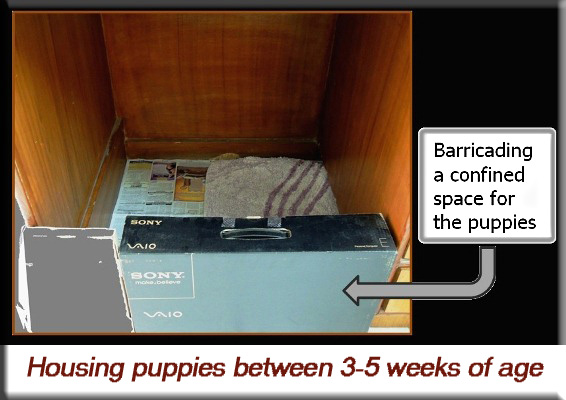
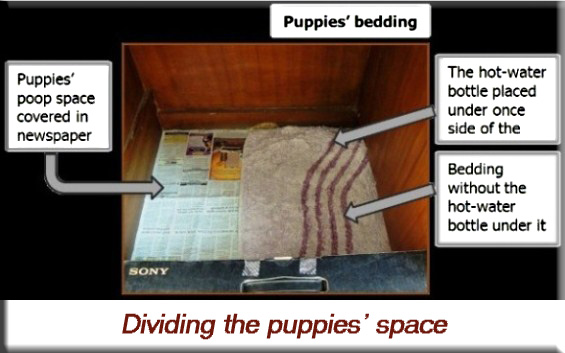
Older puppies needn’t be housed in boxes at all – they can be housed just as you would an adult dog but preferably in a constricted space until they are 3-5 weeks old so they don’t run out of sight and into dangerous places. The space may be barricaded using cardboard boxes, wooden planks, etc. Puppies are likely to try and push their way through the barricade and you must ensure that nothing can dislodge and fall over the puppies. Using books or bricks, for example, can be very dangerous. If the puppies try and push through them – they can crush the puppies if they fall on them.
Puppies of this age are normally only active during meal times. They eat, play for a while and go off to sleep until their next meal time. They must be given free space to play and run around the house when they are awake and returned to their space once they fall asleep.
Puppies beyond 6 weeks of age may be housed just as you would an adult dog. Most puppies are fairly toilet trained by this age and big enough to be allowed around the house.
Quarantining or housing individual puppies
If need be, individual puppies may even temporarily be kept in buckets – this is especially helpful when housing sick puppies that must be quarantined from the rest to prevent cross-infection. Shallow tubs must be avoided as puppies tend to crawl out of them.
N.B. Hands must be washed thoroughly after handling sick puppies and before handling the healthy ones to prevent the spread of infections.
Fleece material, e.g., yellow dust cloth used for vehicles, or woollens must be completely avoided for puppies that less than a month old. The pups may look for the mother and try to suckle on the fibres of the fleece material in their sleep. In doing so, they can ingest the cloth fibres and choke to death.
A hot-water bottle, heating pad or heating lamp is essential for providing external heat for young. If none of these are available, a soda or drink’s bottle may be used as a substitute. The hot-water bottle must always be wrapped in at least 2 layers of cloth (or 1 layer of a thick material) before placing the pups on or near the bottle. The puppies must be monitored closely to prevent either chilling or overheating.
The puppies must never be permitted to come within reach of an uncovered bottle as they can get scorched. Care must be taken to not leave any space for them to crawl under the bottle. To prevent accidental scalding, the hot-water bottle and drink’s bottle must be checked for leakage each time before use. New hot-water bottles too have been found to be faulty and must be tested intensively before use.
A quartz alarm clock too may be used to reassure the young. The ticking of the clock replicates the rhythm of the heartbeat, simulating the mother’s presence and reassuring the young. The clock, with the alarm turned off, can be covered in cloth and placed inside the box.
Feeding bottles and syringes
Small sized feeding bottles and teats are readily available at most pet shops and veterinary clinics. These are ideal for small puppies. Unlike milk bottles for human babies, these bottles are soft and pliable making it easier to coax and even force feed puppies that are reluctant to get started themselves.
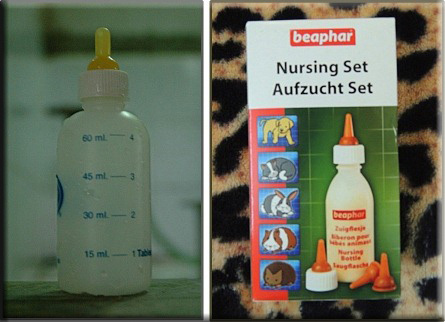
A feeder can be also fashioned either using a pipette or a syringe with the nozzle of a scalp vein set. A 2-5 ml syringe would be ideal for smaller puppies while a larger syringe, 5-10 ml, would be more convenient for older puppies.
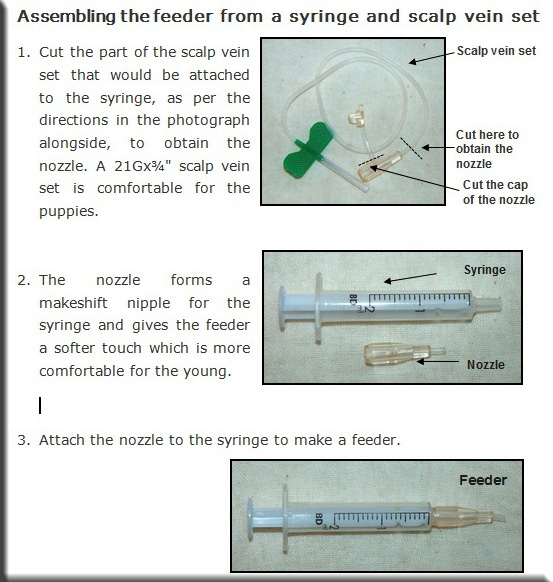
Feeders and hygiene
It is of utmost importance to maintain very high standards of hygiene while feeding the young. Toxins from infections in the gastro-intestinal tract can easily seep through the gut wall and cause systemic toxemia or generalized infections in the young as the gut wall of younger animals is much more permeable than it is in adults. The feeders must therefore be sterilized after every meal.
A simple steam sterilizer or an ordinary kitchen pan can be used to sterilize the feeders. All parts of the feeder must be detached and rinsed in clean water, and then immersed in water and boiled for 5 minutes after the water first comes to a boil.
The syringe feeders will need to be replaced periodically especially when using plastic or disposable syringes. The rubber bulb at the base of the plunger of disposable syringes hardens after sterilizing the feeders a few times, jamming the feeders and making them unsafe for use. Consequently, the syringe feeders must be replaced promptly to ensure smooth and safe feeding of the young. Feeding bottles must be cleaned as per the instructions provided and then sterilized after every feed.
Soap must never be used to clean the feeders. The feeders are very small which makes it impracticable to either thoroughly clean them from the inside or rinse them free of soap residue after cleaning. Inadequate cleaning of the feeders would lead to dangerous levels of bacterial growth on the feeders while leaving soap residue in the feeder too would be very harmful for the young. The easiest and safest method of cleaning the feeders is therefore by sterilizing them.
Feed composition
Diet is a crucial factor in the growth and development of the young. It is vital to offer the young a healthy, nourishing and easily digestible feed. The milk-replacement formula used should be kept as close to its mother’s milk as possible. Puppy milk replacers [for e.g., Esbilac, Lactol or Toplife puppy formula (which contains goat’s milk)] are easily available at most pet stores and veterinary clinics. A puppy milk replacer is ideal for neonate puppies as it is especially manufactured for young puppies and is closest in composition to the mother’s milk.
The next best alternative to puppy milk replacers, when none available, would be Lactogen, Nan or Farex milk formula. The addition of excessive fats and sugars to the formula must be avoided as it can lead to diarrhoea. Lactose too poses a serious challenge when using cow’s milk for the young and fresh cow’s milk is therefore best avoided for small puppies. Older puppies may be offered cow’s milk if and only if they seem to digest it well.
While most puppy milk replacers have sufficient vitamins and minerals added, nom-specialized formulas might require additional vitamins. Infant veterinary or paediatric vitamin drops can be added if necessary but must be done carefully as an excess can cause diarrhoea.
The addition of prebiotics, probiotics and digestive enzymes are crucial for the digestion of puppies that are only on milk. Specialized veterinary probiotics like Gutwell, Fortiflora, or Protexin’s Pro-Kolin, Pro-Solubale or Bio-Premium may be used for the puppies. The next best alternative to veterinary probiotics would be human probiotics like Sporlac, Bifilac, Vibact, etc. that mainly contain the beneficial bacteria, lactobacilli. Older puppies may be given probiotic chews like Vetri-Science Probiotic or Prostora Max. A pinch of probiotics added to the puppy’s feed 2-3 times a day suffices most puppies. Dosages may differ according to the size of the puppy and the supplement used and it would be best to consult a veterinarian for the exact dose and frequency.
Feed consistency
Feed for the neonates would be of the consistency of milk while the feed for older puppies may be of a slightly thicker consistency than milk, for e.g., like milkshake. It is essential to prepare the feed to the right consistency as thicker feeds provide inadequate water for the young and can prove to be heavy for the pups to digest. Diluted feeds, on the other hand, may not provide enough nutrition for the young and would affect their growth and development.
Milk Formula
Only boiled water must ever be used to prepare the feed. Refrain from preparing the feed in plastic containers as they are concerns over chemicals like BPA leaking into the formula if stored and heated in plastic containers. A fresh batch of feed must be prepared every day as using stale feed can lead to infections. Feed prepared for the day must be immediately refrigerated upon preparing and only the quantity required per feed must be heated each time. The remainder of the feed must be discarded after feeding the pups.
N.B. The feed must never be reheated more than once as it promotes bacterial growth and can lead to severe food poisoning.
Feed for the neonates
Feed for the neonates: Day 0-7
New-borns, at birth, would be fed on Colostrum, the very first milk produced by the mother at parturition. Colostrum is very thick, creamy and yellowish in colour, and has high concentrations of proteins, nutrients and anti-bodies that are essential to protect the new-born against many infections at birth. Neonates that haven’t received colostrum need particular care in terms of hygiene as they lack the maternal anti-bodies that help to fight infections.
New born puppies will drink roughly 30-40% of their body weight in a day. A 100 gms puppy would therefore require about 40 ml of feed in one day. A puppy requiring 40 ml in the day can be given about 5 ml per feed 8 times a day. If the puppy isn’t making up its daily average, the frequency of the feeds can be increased. Refrain from increasing the quantity of the feed at least until the puppies have settled and stabilized.
Feed for the neonates: Day 8-14
The formula can be increased to normal strength if the pups seem to be digesting the feed well. If not, a mildly diluted concentration of feed must be continued. Egg yolk and puppy weaning powder like Samolac or infant cereal like Nestum must be introduced in minute quantities [roughly 10% per feed 2-3 times a day] in the second week of the puppy life. A milk-based infant cereal, for e.g., Cerelac, may be introduced instead of simple infant cereal but this would require you to reduce the quantity of the milk formula so as to maintain an adequate ratio of milk to cereal. Adding infant cereal ensures adequate nutrition by increasing the density and calorific value of the feed as also encouraging good digestion and growth. The quantity of egg and cereal should be increased gradually. By the end of the 2nd week, the quantity of feed being consumed by the pups would approximately triple of that consumed by them on the day they were born.
Formula to be used once the eyes open: Day 15 to 1 month old
The digestive system of the pups is stronger by the end of the second week and there should be little concern in feeding them anymore. The formula can be prepared as per the given instructions and you will not be required to dilute the feed anymore. The quantity and frequency can gradually be increased over a few days until the puppies are consuming 25% of infant cereal and 25% of egg yolk per feed. By the end of 4 weeks, each puppy [of medium-sized dogs] can be given one egg yolk every day. Additional vitamins and calcium must now be added to the puppies feed as required.
The importance of boiled egg yolk
Egg yolk also contains many essential minerals and fats which increase the nutritive value of the feed. Raw eggs can carry the bacterium, Salmonella Enteritidis, which can lead to severe food poisoning and pose a serious threat to the young. Pasteurised eggs, if available, may be used raw, but only fully boiled eggs must be used otherwise.
Feeding
The puppies must always be given a warm (not hot) feed simulating the temperature at which the young would receive milk in nature as it is soothing, easier to digest and they feed better. Cold milk on the other hand must be avoided altogether as it can chill the young and even cause cramps. The pups must be given small feeds frequently as longer gaps between the feeds tend to weaken them.
Puppies always lie flat on their stomachs when suckling on their mothers. It is unnatural for them to lie on their backs and suckle. Holding them vertical or turning them on their backs may only lead to accidental aspiration of the feed. Puppies must be held horizontally (like in the picture above) while feeding them to prevent aspiration, i.e., inhalation of fluid. This also prevents the feed from entering the airway in case too much feed is accidentally pushed in as the surplus feed can drip down the sides of the mouth.
The pups must be fed slowly while maintaining a steady pressure on the feeder and allowing them to suckle. If unsure about how to feed the young, it is safer to drop tiny droplets of milk on their tongue and allow them to lick it. Never use excessive force whilst feeding the pups if the feeder appears to be stuck. The feeder must be removed from the puppy’s mouth and readjusted until the obstruction has completely been removed before continuing to feed. This prevents accidentally squirting too much feed into their mouth and aspirating the young.
Puppies that refuse to feed
Most puppies will protest to the feed and the feeder for the first few feeds. It is unnatural for them to drink from artificial feeders and it is a skill that they will have to acquire. Once fed appropriately for the first few times, all puppies will readily accept the feeder whereas struggling with the feeder will only lead to negative conditioning and rejection of the feeder.
A puppy must never be fed with force even if it is crucial to keep the puppy alive. It is usually more effective to give the puppy a few drops at a time and then pull the feeder away and give it time to swallow the feed. The feeder must never be pushed into the mouths of puppies that refuse to suckle on the feeder. Instead, slide a finger in to the side of the puppy’s mouth and then offer the feeder (like in the picture above). The finger can be placed in the puppy’s mouth if it helps him/her feed. Once feeding continues in a pleasant manner for the puppy it will soon readily accept the feeder.
Aspiration pneumonia
The repeated inhalation of either oropharyngeal or gastric contents, for e.g., milk, into the lower airways can lead to an infectious process causing aspiration pneumonia. Aspiration pneumonia is one of the most common causes of mortality in hand-raised animal young and every care needs to be taken to minimize this risk. It is vital to ensure the use of the correct teat with an appropriately sized hole, correct feeding position and handling, correct milk temperature, and avoidance of overfeeding or force feeding to prevent aspiration pneumonia. If it is suspected that the pups have aspirated the feed, for e.g., if the pups sneeze or cough up milk after a feed, a veterinarian must be consulted to begin the preventive treatment without delay.
Ano-genital stimulation
The muscle and control of the gastric tract are poorly developed in the young and it is essential to stimulate the ano-genital area very gently with a warm, wet cloth after every feed for the first 3-4 weeks of the puppy’s life. A gentle body rub, with emphasis on the bottom half of the body, the upper thighs and the buttocks, also encourages urination and defecation. Stimulating the puppy for a few minutes after a meal will ensure that the puppy relieves itself. Once the puppy relieves itself, it will immediately go off to sleep. Failure to do so results in constipation, bladder problems, uraemia and even toxaemia.
Another major advantage of proper stimulation is that the puppies pee and poop outside the box which makes it easier to keep the box clean. Young puppies don’t have the sense of judgement to avoid the soiled area of the box and tend to walk all over the poop. Even if one puppy poops, all puppies will inevitably walk/roll over it, necessitating a thorough cleaning for everyone!
Sponging
It is a good practice to gently sponge the pups with a soft cloth dipped in warm water 2-3 times a week as it helps keep them clean. Giving them a warm sponge also simulates the mother’s licks and adds to a feeling of security. Puppies feed well and in turn grow better and healthier when they grow with a feeling of safety and comfort.
The pups must only be sponged (never bathed) during the day and dried immediately using a dry towel. They must never be sponged at night as it can rapidly chill the young. A hairdryer must never be used to dry the young – they must be allowed to dry naturally or be exposed to mild sunlight.
A drop or two of a mild shampoo can be added to a small bowl of water for sponging pups that appear to be rather dirty, for e.g. those that have been recently rescued and are unclean and smelly, or puppies that have soiled the box and rolled over in the poop. The shampoo helps to clean them up and leaver a sweeter smell. If using shampoo, ensure to wipe them up with another wet cloth so as to leave minimal residue on the pups. Excessive residue might go into the eyes of the puppies or cause allergies.
Puppy poop
Poop is a good indicator of digestion. It is essential to keep an eye on the puppy’s poop to make sure they digest their food well. The droppings should all be well formed and will appear somewhat granular in smaller puppies. The poop shouldn’t be too sticky and you should be able to lift it with a piece of tissue without causing any staining.
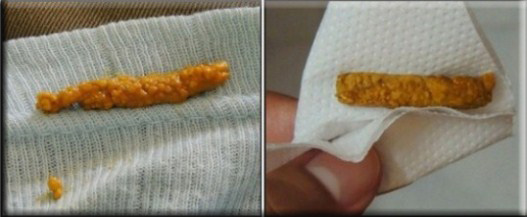
Poop that is watery, pasty or excessively sticky indicates that the puppy isn’t digesting the feed very well, and hence also not absorbing adequate nutrients out of the feed. It will be necessary to make changes to their diet if they don’t digest their feed well. Seek guidance from a veterinarian to make the appropriate changes to the puppy’s feed.
Tummy upsets
Tummy upsets in young puppies are most often due to the indigestibility of the feed. The puppies’ feed, formula and feeding routine changes frequently, requiring a lot of effort from their little bodies to keep up with all the changes. Often, just adding a bit of fresh curd to their meals aids their digestion. Adding 20-25% yogurt to the puppy’s meals 2-3 times a day should aid the puppy significantly. Puppies with more sensitive systems may be given curd in every meal if required until their bodies adjust to their feeds.
Puppies with tummy upsets due to indigestion can be offered whey (dahi ka pani) for a couple of feeds until their stomach settles down. Once the puppy’s stomach starts to settle, its poop will be better formed and feeding must resume slowly with subsequent feeds being a mix of whey and curd, followed by a combination formula and curd. If excessive water loss is suspected, a pinch of electrolytes must be added to each feed and discontinued once the puppy appears better.
The only problem with curd is that it is often cold and warming it up tends to curdle both the curd and the feed. Fresh set curd is ideal for use as it is warmer and can safely be mixed with a warm feed. The best way to warm up curd is to take some curd in a bowl and then place the bowl in another bowl of warm water. This procedure must be repeated twice, the second time with warmer water. This prevents the curd from curdling. Curdled curd must not be used for the pups.
Warmth and well-being
Mammalian young thrive on warmth and touch. They love to be held and stroked. This is especially important when handling lone youngsters. Holding small puppies close to your chest gives them a feeling of reassurance as they listen to the rhythm of your heartbeat. Babies of mammals always huddle close to their mother’s chest and tummy and feel reassured being held in a similar fashion.
Animal young rarely vocalize unless they are in need. The puppies will vocalize when they are hungry or need to relieve themselves or if the temperature of the box is either too warm or too cold. Often, the pups will even vocalize when they just want to be held. It is important to check on them once they vocalize as ignoring them for prolonged periods will lead to a feeling of neglect and insecurity.
Sexing puppies
Sexing puppies is rather simple. The genitals of both male and female puppies are clearly visible right from birth.
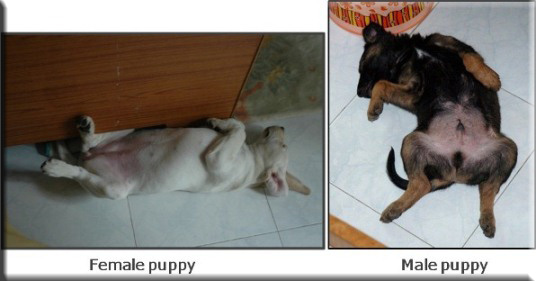
Ectoparasites
New-born puppies are quite unlikely to be infected by external parasites, i.e., fleas and ticks. While those found at a later stage might have severe infestations. Although it is not recommended to bathe small puppies, I find it easiest to give the puppy a good bath and manually remove all ticks and fleas. I prefer using Canifur shampoo for the puppy’s bath and find the combination of using a good shampoo with removing the fleas/ticks immediately after a bath quite effective.
The next alternative would be to use a spray or powder to rid the puppy of the ticks and fleas. Frontline or Protektor spray (containing Fipronil, a broad spectrum insecticide) has been used successfully to treat severe infestations of fleas and ticks. The instructions to using the product are given on the literature provided with the spray. The guidelines in the literature provided along with the spray must be strictly followed for optimum results and the safety of the pups.
The solution must not be allowed to come in contact with the puppy’s eyes. The pups must be allowed to dry up themselves after using the spray. The spray must therefore only be used during the day as it takes a while for the puppies to dry up and they might catch a chill if left sodden for long at night.
The fleas tend to multiply in the puppies’ bedding as well and will repeatedly climb onto the pups from their bedding. It is therefore essential that the fleas not only be eliminated from the puppies but also from their bedding. Although it is ideal to use a fresh set of bedding after the application of the spray, the spray can also be applied to the bedding to eliminate the fleas.
Caution: Frontline and Protektor are both very toxic.The spray must be used very cautiously and would necessitate a watchful eye on the pups for a couple of hours afterwards. The above mentioned sprays can both be purchased from a veterinary clinic or a pet shop. I recommend you consult a veterinarian if unsure about its usage.
Continue to Page 2: growth and corresponding care
Please note: This document is targeted at hand-rearing alone and does not address or substitute any veterinary procedures. For any medical concerns, please consult your veterinarian at the earliest.
For amateurs or people handling a new born puppy for the very first time, please keep in touch with a trained and experienced hand for guidance and regular progress updates.
Protocol published in 2012

